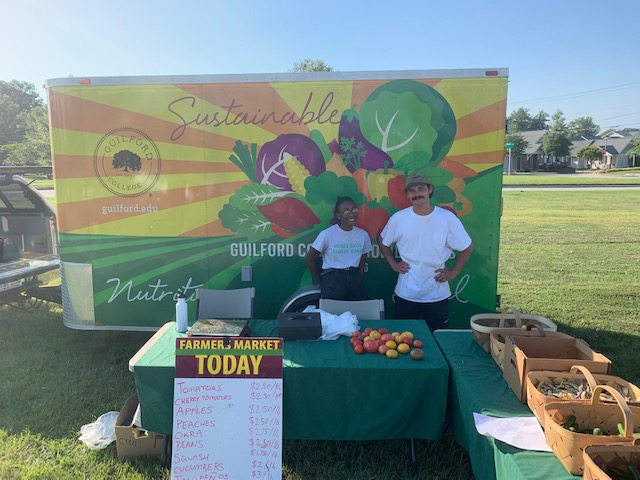University of Buffalo grants Bonner Center’s Mobile Oasis funding for local food research
Guilford’s Bonner Center for Community Service and Learning’s Mobile Oasis program recently announced that they have received $50,000 in funding from the University of Buffalo’s Veggie Van project.
“(Mobile Oasis is a) mobile farmers market bringing local produce to local food deserts,” explains senior and political science major Jackie Sullivan.
Bonner Hunger Fellow, Guilford senior and Sustainable Food Systems and Political Science double-major, Mallory Cerkleski, explains the overall significance and reasoning of this funding for Mobile Oasis.
“The grant is research based,” Cerkleski said. “All the money should be used to pursue research trying to see if the presence of a mobile market increases the intake of fresh fruits and vegetables.”
In the process of applying for the initial grant, Cerkleski explains that she and fellow Mobile Oasis team member, Ana Huckins, “reached out to different communities in Greensboro to see if this research would be something they would want to participate in.”
“We chose four sites based on that: Oakwood Forest, Warnersville neighborhood, Grove Street People’s Market and a fourth site that eventually dropped out, and we are in the process of trying to figure that out,” Cerkleski said.
Out of over fifty applicants, Mobile Oasis was one of only nine of its kind chosen across the nation to participate in the Veggie Van project.
Lucia Leone, assistant professor of community health and health behavior at the University of Buffalo and primary investigator in the study, explains that its goal is “to know if having these mobile markets in communities that have limited access to fresh produce leads to changes in what people are eating.”
Cerkleski elaborates on the recent progress regarding the project.
“The Veggie Van team recently came to Guilford to have site meetings, where they met the first two sites: Grove Street and Oakwood,” Cerkleski said.
The research will be starting around Nov. 1, where, Cerkleski says, there will be a “staggered timeline when each site is going to start the data collection.”
She explains that the study will consist of “two sites that start data collection at the same time. One is deemed a market site and one a planning site.”
There will be a three month data collection period where consumers are given forms asking questions like “How many fruits and vegetables do you consume on a regular basis?” and “Would you attend a mobile market if there was one in your neighborhood?”
After this, both sites will get 60 interest forms, and if 30 people consent Veggie Van will begin doing research over phone calls to the site members and finally in-person physical data collection of things like height, weight and vegetable intake using a tool called the “veggie meter.”
While the first two sites are going through the process of data collection, the second two will begin with the exact same process “so there’s repetition in our research,” according to Cerkleski.
Although this is a hefty grant, Cerkleski emphasizes that it is only for research purposes, not for the expansion or support of Mobile Oasis as a program.
“Mobile Oasis should, technically, as a non-profit, be running off of grants, but we haven’t had one since 2018,” Cerkleski said.
Cerkleski’s primary goal for the Veggie Van project is for Mobile Oasis to build strong relationships with these four sites, but she believes that “for that to happen there really needs to be a full time employee. It can’t be students anymore … to be able to do all the things that Mobile Oasis has the potential to do.”
Fellow Mobile Oasis coordinator, Huckins, agrees that Mobile Oasis needs a consistent staff.
“Sometimes it feels like we are running a whole non-profit, which is kinda crazy,” Huckins said. “But a few weeks ago I was at market, and someone came up to me and said, ‘I was going to go to the grocery store yesterday, but then I remembered that you were coming today and I could buy produce from you instead,’ and that reminded me of why I do it.”
The communities are just as invested in us as we are in them, and it just makes all of this work feel so much more valuable”.
Editor’s note: This story originally was published in Volume 106, Issue 4 of The Guilfordian on Nov. 1 2019.





